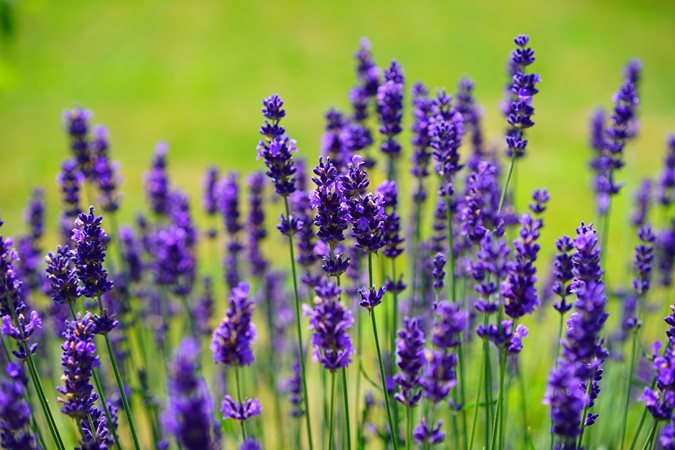Real lavender is the Mediterranean garden classic par excellence. It blooms for weeks in countless gardens and spreads its lovely fragrance. The characteristic flower spikes, usually violet but also bright blue depending on the variety, are of course a highlight of the garden season. To ensure that the semi-shrub remains compact and always flowers diligently, you should prune your lavender – preferably twice a year.
Contents
What is the effect of pruning?
Most lavender varieties are perennial, so you can enjoy the fragrant plants for a long time. If you prune lavender, you will get a compact, shapely growth. In addition to the right time, the age and condition of the plant is also important.
Lavender is a semi-shrub, which is why it is naturally woody. This means that the plants form thicker stems over time, which bear neither leaves nor shoots. This phenomenon is also known as callus. If the plants are left to grow unpruned for years, they will lie on their sides due to their weight and lose much of their beauty. With regular pruning, the lavender forms new shoots at the base of the plant and becomes woody much more slowly. It also branches out much better and grows more densely.
The choice of tools
For older specimens or when there is a lot of thick dead wood to remove, a sharpened pruning shear or rose shears should be used. For lavender shoots that are still thin and leafy, on the other hand, a hedge trimmer is a good choice. These can be used to cut the shrub evenly into the shape of a hemisphere.
When should lavender be pruned?
The date for spring pruning needs to be well calculated. The end of February is a good starting point. However, long periods of frost should no longer be expected. Freshly pruned plants are more susceptible to frost, which often results in cold damage. At the same time, it is better to prune before new shoots appear on the plant. If you remove the fresh shoots, you slow down the lavender in its first growth spurt. If you miss the time, do not prune later, but wait until late summer.
Because the second pruning of lavender shrubs takes place in late summer anyway. The ideal time is when the flowering period of the lavender is coming to an end. Seed formation normally begins immediately after flowering. Timely pruning ensures that the plant does not channel its energy into seeds, but is motivated to flower a second time. Under no circumstances should pruning take place in autumn, because otherwise the new shoots will not be winterproofed in time and will be in danger of freezing later.
How should you prune lavender?
In spring
When pruning in spring, you may be generous. Normally you can cut the lavender shoots by about half or up to two thirds. As a general rule, you can prune young plants more than old ones. If the lavender already has longer, woody branches, a more restrained approach is recommended. Use the previous year’s shoots as a guide and prune slightly above them. The cutting point should be “in the green”. A somewhat rounded shape suits the lavender particularly well. This means that the edges should be cut slightly shorter than the shoots in the centre. Also remove dead plant parts with a clean cut directly at the base.
If the shears are placed too deep in the old wood, there is a risk that the plants will not sprout again. With professional pruning, the lavender usually looks as good as new again after about a month. And in the coming summer, countless flower spikes will once again adorn the fragrant half-shrub.
Summer
The second pruning is done in late summer. This is done by cutting back a little less. Remove mainly the withered flower spikes. This will stimulate a second flowering phase. You can also cut back a small part of the leaf shoots again. But this is not a must.
Pruning lavender: Rejuvenating older plants
Rejuvenating an already heavily woody lavender can be risky for the health of the half-shrub, especially for very old specimens. Rejuvenation pruning is usually used when a plant needs to form more branches again and gain new flowering vigour. A lavender that has not been pruned for a long time usually falls apart unsightly and has only a few thick shoots in the lower area. Success is not guaranteed, but it can be worth a try. It will be gentler if you spread it over two years.
If you want to prune an older lavender, it is advisable to do so in July, when the usual summer pruning takes place. To do this, cut back the oldest branches a few centimetres above their first fork. Unlike other shrubs, lavender shoots should not be cut off close to the ground.
Excursus: Harvesting lavender flowers
If you not only cultivate lavender for ornamental reasons, but also want to harvest the lavender flowers and use them in the kitchen or medicine cabinet, you will of course need to cut the flowers at a different time. The true lavender (Lavandula angustifolia) is used, for example, to flavour food or to extract its essential oil. The right time to harvest the flowers is just before the spikes have fully blossomed. Some of the individual flowers may already be open, but the majority should still be closed. The aroma and fragrance are strongest at this time. It is best to choose a warm morning without clouds in the sky for the harvest cut. Cut the stems about 10 to 15 centimetres below the flowers.


